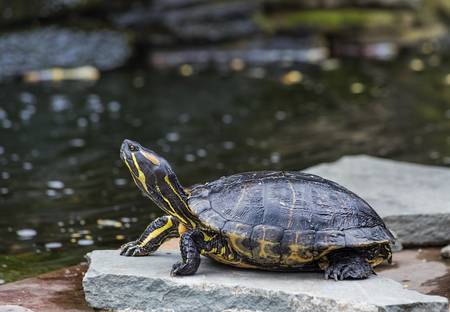ANIMAL: Painted Turtle Chrysemys picta Type of Animal: Turtle Habitat: Ponds, lakes, marshes, sloughs, creeks, streams, pasture ponds, roadside pools, shores, coves, rivers, swamps, drainage ditches, pools, wet meadows, bogs, prefer still/slow-moving freshwater but sometimes in brackish tidal waters, salt marshes & nearby shores, prefer areas w/ soft bottoms/aquatic vegetation/areas w/basking sites Location(s): Found from S Canada to Louisiana & N Mexico, & from Atlantic to Pacific. Invasive in California, waterways near Phoenix & Miami, Germany, Indonesia, Philippines, & Spain. Appearance: Eastern subspecies-olive green to black carapace (upper shell), w/pale stripe down middle & red markings down periphery, carapace scutes have pale leading edges occurring in straight rows along back, unlike other 3 subspecies/other N American turtles w/ alternating segments, bottom shell (plastron) yellow/lightly spotted. Midland subspecies-plastron has symmetrical dark shadow in center. Southern subspecies (smallest subspecies)-prominent red stripe on top, tan/spotless/almost spotless plastron. Western subspecies (largest subspecies)-Mesh-like pattern of light lines on carapace, very little top stripe, large colored splotch w/ red hues on plastron. Face on all subspecies has yellow stripes w/ large yellow spot/streak behind each eye, webbed feet, females larger than males, male has longer foreclaws/ longer thicker tail, female has more rounder/less flat carapace, hatchlings have proportionally bigger head/eyes/tail & more circular tail, males have concave plastron Food/Diet: Fish, worms, insects, greens, leaves, vegetables, aquatic plants (especially duckweed, water hyacinth, water lettuce, water lilies, pondweed etc.), crayfish, frogs, carrion, insect larvae, algae, white water-lily seeds, fruit, shrimp, mussels, snails, leeches, crabs Status in Wild: Stable Conservation: Breeding from zoos, aquariums, nature centers, & private breeders. Lifestyle: Can be found in groups of up to 50 turtles. Additional Info: Called: Male Female Young-Hatchling Group-Bale Weight: Male-11 oz Female-18 oz Young-0.8 oz Gestation: 2.5 months Life Span: 30-50 years Body Length: Male-3-6 in Female-4-10 in Young-1 in Main predators of adults are crocodilians, foxes, raptors, snakes, corvids, raccoons, badgers, wolves, dogs, coyotes, mink, otters, snapping turtles, herons, & bobcats. Young preyed on by skunks, muskrats, large frogs, bass/catfish/other large predatory fish (some even take adults), water bugs, birds, rats (some species eat small males), weasels, many rodents, & other larger turtles. Some rodents/birds only eat eggs. Males sexually mature at 2-9 years, females sexually mature at 6-10 years. Fun Fact(s): Can shed their shell as they’re growing. Can live w/o external oxygen supply for months.

